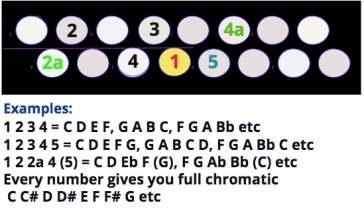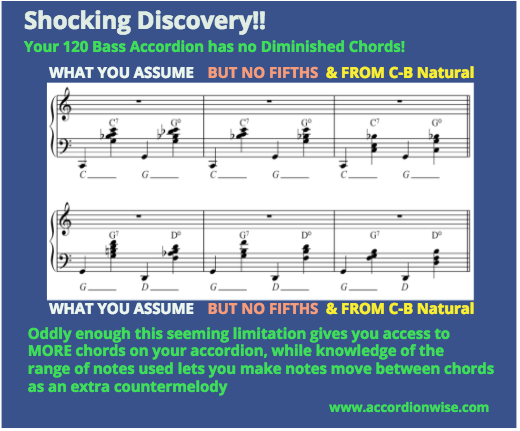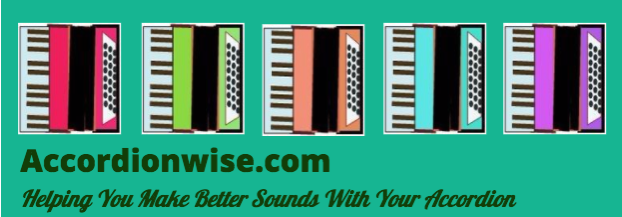I HOPE YOU ENJOY THIS WEBSITE
My name is Alex Govier, a professional musician on accordion, piano and organ for over 50 years.

On this website I am sharing stuff to
- Improve your technique
- Help you get to know your instrument better
- Play more easily and more confidently
- Try new accordion bass methods
- Integrate bass and treble sounds in different ways
- Learn how to make better music
- Gain popularity with general music listeners and not just fellow accordionists.
And yes, ALL CONTENT ON THIS WEBSITE IS FREE.
Simply because I would like more general appreciation of this wonderful instrument.
Because by playing a little more thoughtfully we can reach new audiences and get more recognition.
Find when there is new stuff on this website by joining our new Facebook Community
Here you can also
- interact with this website on Facebook
- Ask questions
- Request more detail on an accordion subject
- Suggest a new subject
- Tell us your own ideas and more.
The Accordionwise Friends link
You can find my personal playing sites on

On this Page You will Find More Than Two Dozen ideas to Transform your musical effectiveness by extending your use of accordion stradella bass
There is so much more you can do beyond what you were taught in your first accordion lessons. And most of it requires just musical insight, as shown on this page, rather than amazing physical dexterity.
In other words to help you put your music together better, to match that applied on other instruments and arrangements, so your music makes a better sound.
![]()
A Map so you Really Know Your Way Around
You may find the following graphic a helpful reminder to help you find your way from note to note. I tried to include most of the relatively finger friendly ways around. As it already had so much to read I left out the alternative ways to find major thirds and fifths.
Such as going up a major third by missing three buttons between in the same row, or going up a fifth changing rows by missing two buttons down and going to the counterbass. These are correct but not that easy to reach without considerable disruption.
These and other obscure back roads may eventually even serve a purpose in helping you use chords when you do strange key changes but if you know all these in the chart underneath so you can automatically reach for them you will have a special freedom in your playing.
This looks rather confusing at first, there is such a lot there but just look at one item in the diagram at a time and it should be very clear.
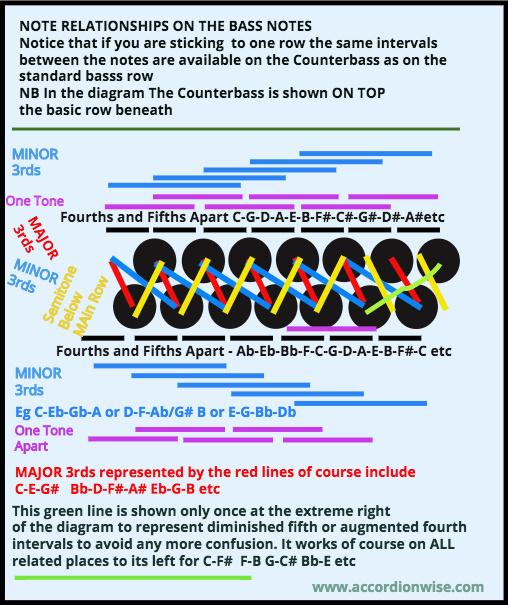
Notice that there is no mention of sixths. This is because in stradella bass a minor 6th down (eg C down to E) is the same as a major 3rd up (such as C up to E), and a minor 3rd down is the same as a major 6th up. So everything is covered. Also normal 7ths are just a tone apart turned upside down and a major 7th is just a distance of a semitone upside down.
Further down the page you will also see another diagram for semitone gaps both up and down as there was not room on this diagram. All these are very practical to use, obviously there are some virtually impossible jumps to get the same thing!
Copy this if it seems useful for you and please credit this website if you would like to distribute it.
There is more on this subject on individual bass moves below.
![]()
Find Notes from Basic Row to Counterbass
Staying within the same row, either the basic row or the counterbass row, to find extra notes is easy but limited.
You have notes a fourth or fifth apart from one to the next up to a key with one more sharp or one less flat and down a button to a less sharp or more flat key.
Notes on alternate notes very easily give you normal next door notes, tones of course so not semitones, for examples D to E, not D to E flat. One more move apart will give you a minor third down or a major 6th up, for example C to A.
However there is an equally handy position for this as you will see below by missing out one key signature range button and going from basic row to counterbass. This may often be more useful to keep you in the same area of the keyboard or when you have a finger available in that direction to play it.
Distances between notes bass to counterbass
Here is the main directions for finding a note in a particular interval in the counterbass from a starting note in the main bass note row.
This will work well as long as you can identify what kind of distance move you want to make (what interval). So for instance if you know you need a major 3rd up you will find it easily on the adjoining counterbass, going from 2 to 3, or 3 to 4, or possibly even 4 to 5 choosing your fingers.
Less useful of course if you are not sure whether it is major or minor of course, or worse, whether it is a 3rd, fourth, fifth or sixth that you need!
So dont worry there are a lot more example diagrams below to help from specific notes.
General Principles finding intervals bass to counterbass
Very helpful to know this but we will help you do without it for now
Distance of a minor 3rd, counting every note including your starting note stop on 4
Major 3rd stop on 5
Perfect 4th stop on 6
Augmented 4th or diminished 5th (the same distance) stop on 7
Because there is only one of each note to play on stradella bass the following intervals are played the same.
Minor 6th (stop on 8) same as MAJOR 3rd
MAJOR 6th (stop on 9) same as minor 3rd
Normal 7th (stop on 10) same as a tone apart
Major 7th (stop on 11, 12 would get you to the same note) same as a semitone

More Specific, showing starting from C in bass row
Note that to give the correct impression of the intervals the spelling of the notes is sometimes changed between sharps and flats. This does not alter that when you go from C# to Ab for instance it is still the normal perfect fifth distance you would expect between adjoining buttons in the same row.
This makes it appear that they are a fairly nonsensical diminished 6th apart, theoretically possible, but almost never used. The same number of notes apart as a perfect fifth obviously since there is nowhere else to go!

More specific, showing starting from G
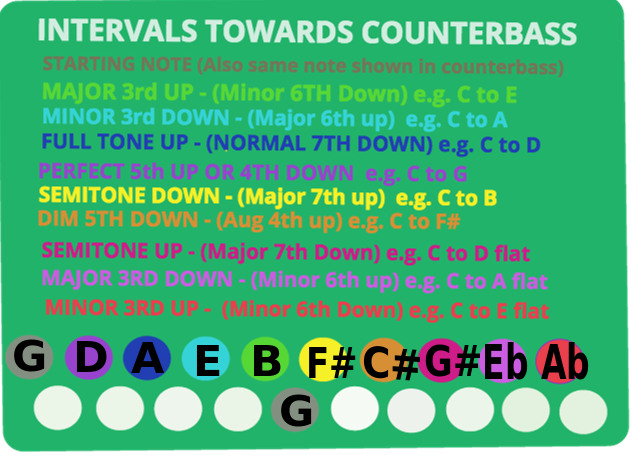
More specific starting from D
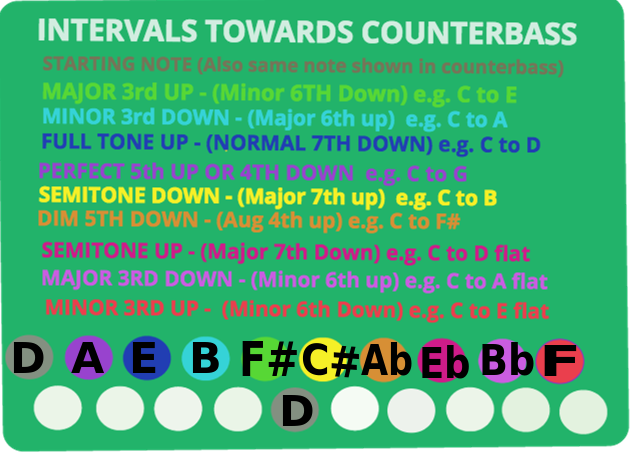
More specific starting from A
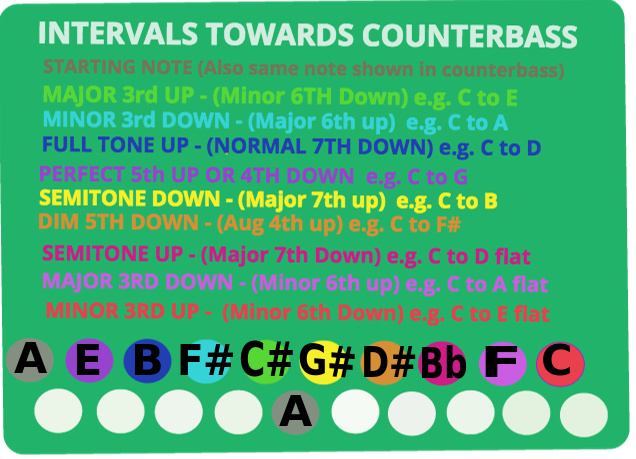
More Specific starting from E
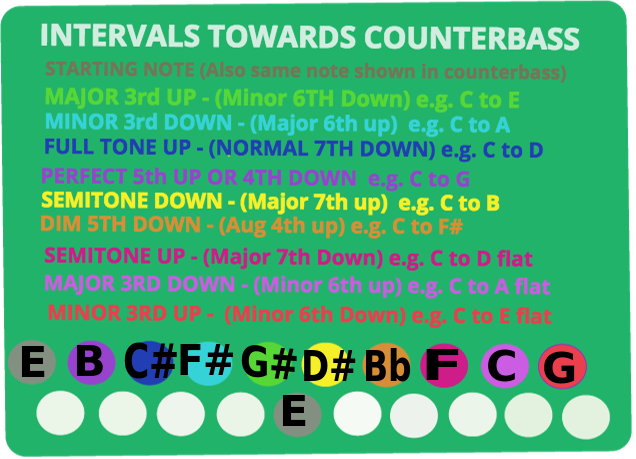
More specific starting from B
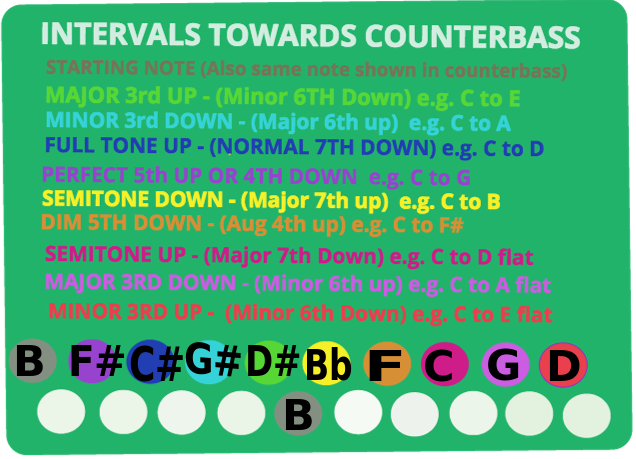
More specific starting from F

More specific starting from Bb
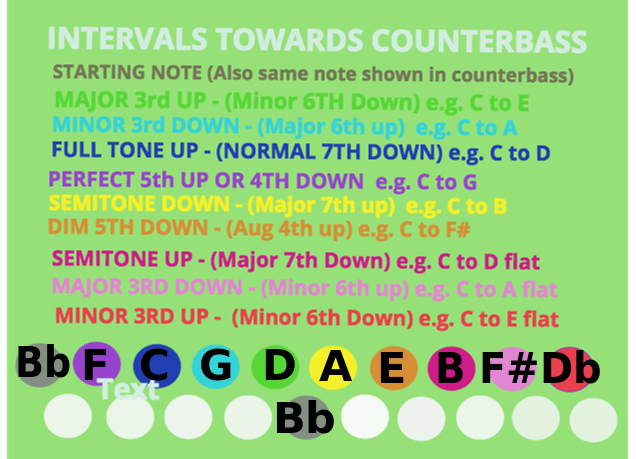
![]()
The purpose of bass buttons. What can the Bass buttons Do Musically?
At the most basic level they are of course used to stress the main beats of the bar 1 and 3 in four time, or just 1 in waltz time. Doing this is a habit that forms to help your playing but unless varied can become a bad habit.
With the C chord you have an alternate note you can use, G (which we will call the dominant) instead of C (which we will call the tonic)
There is also the subdominant the note below your C note or tonic note (in this case F of course) whichever one you happen to be using, but this is rarely useful in conjuction with the tonic chord
OK you already know all this, despite my probably overcomplicated description
Although you can do that amazing thing of alternating your bass notes between tonic and dominant notes, this is not always the best use. There are many circumstances where sticking to the tonic will sound better for a while.
Rock beats, latin tango and rhumba will sound better often if you leave out the alternate dominant note in your pattern, at least until the new note points to a new section or a change of chord.
Do not alternate the bass notes mindlessly. Bear in mind what it will sound like.
![]()
They can play linking short melodic bass runs which will be very noticeable
These are runs which link important bass notes, often between phrases of a tune.
They might be just running up or down through the scale till they get to the right bass notes, or using notes of the chromatic scale, or a combination.
They can even lead you back to the same note you started with if there is no chord change, such as going around the note and back to where you started or more complex moves.
You will find useful basic stock examples of this further down this page
![]()
They need not be one note to a beat
They do not have to be this predictable.
Even inside a basic beat you can insert half beat quaver runs or even triplet quaver runs and avoid a constant stodgy beat, without losing the pulse of the tune.
Or hang on to a 2, 3, or 4 beat note where it works well and helps the melody by not obscuring faster notes happening there.
![]()
They can temporarily stop to allow more complicated or interesting bits of melody to show through
Difficult to explain quickly but this can include not starting on tunes with a fast run or a phrase starting after the first beat of the bar, eg in Quando quando or Am a Pola, coming in on the first beat of the next bar instead.
While faster sections are happening inside a melody you can even leave out individual notes or chords inside your established pattern to give a lighter brighter more flowing musical texture.
![]()
The bass notes could sometimes take over the melody
This might be just doing alternating phrases between treble and bass side of your accordion or even playing the middle eight completely on bass notes, or even adding harmony in the bass side with it where practical.
Why? Instant tone changes and if the bass is playing a simple bassline melody you could even do some amazing accompaniment stuff on the right hand the left side could never do.
So the bass note plays a part of the tune and the right hand can take over with a part involving lovely moving arpeggios, runs and different chord inversions over its final held note.
This can sound absolutely wonderful particularly if you assign your expression from bellows, legato playing with phrasing breaks to the bass section.
![]()
They could accompany the treble using bass notes only
That way you may be able to play your chords on the right hand, including if you wish impossible jazz chords.
You can also sometimes use this to allow for impossible fast chord changes, for example playing G F# F E. These chromatically sliding chords are very very easy on piano and guitar, but not on accordion bass obviously!
![]()
They can outline chords or even play a version of Alberti Bass
Instead of playing a C chord you can playing its notes, C E G on the note buttons alone. It can sound nice and lively particularly if you get all three of them inside one beat.
Alberti bass is similar and was used to make the chords last longer on instruments like harpsichord or the very early pianoforte which were not good at sustaining sounds.
For example two beats of G and then two beats of D7 might have been played as

Note the A and F# after the D7 chord symbols indicating the lowest note of that particular inversion you are playing.
With accordion chord playing of course you do not normally have control of the inversion played. Because the reeds available are within a particular octave you have to accept them in the order that fits what uis there.
This is one of the "delights" of the accordion that one chord change can sound entirely different to another as to where the notes move within them. Also one of the justifications for free bass instruments to control this, buty to my mind at the expense of the natural rhythmic functions of stradella bass.
![]()
You can shadow the tune in thirds or sixths
Instead of strengthening part of a melody line by playing the same notes in the bass you can shadow it in sixths or thirds under it. For instance under a melody line of C D E G F you could play either A B C E D in thirds or E F G B A in sixths underneath. Notice that your choice will change the chords that are inferred by the combinations.

In other keys you would normally keep to the sharps and flats where they occur in that key (unless wanting to deliberately infer different chords or a temporary key change)
SPECIAL NOTE: While I have given you above a fairly extended and challenging example, in actual practice you may find this shadowing in 3rds is most effective when used with only 3 or 4 note phrases!
![]()
You can Play Bass notes and chords Plus different Right Hand Chords Simultaneously to play bigger fuller sounding chords
In this way you can build up complex but sweet sounding majestic chord textures and chords you could not get otherwise.
For example play C with C chord in the bass and E minor (E G B, or G B E) and you have a really big and full sounding C Major 7 chord (with sharpened 7th). Virtually any chord can be built up 9ths, 11ths, 13ths and because some of the notes are in a different octave range you do not have the unpleasant clashes you get trying to add bass chords together, but a big beautiful almost orchestral sound.
You will not know how wonderful a sound your accordion can make till you try this. A totally different effect from starting with the discord on a main beat and resolving it on a weaker beat or halfway trough the main beat.
Extend this further by sliding in the right hand between chords that seem to make sense and ones that will clash. Complete suspended chords or passing chords you might call them and this can sound mellifluous and interesting.
You may even have more than one passing chord before you get to the conventionally pleasant one. Playing in triplets or even semiquavers onto the next conventional chord combination.
Note that combining different registrations between treble and bass will have different effects. You may find working in a higher octave of the treble keyboard with a strong register which includes the lower reed set will work best, or just using a lighter sound without the lower reed set. Or using or not using a tremolo tone. It is up to you so just experiment and see what seems to suit you.
![]()
It might Even Simulate full accordion Arpeggios
Traditional players and those with a speciality in Free Bass playing are going to absolute HATE this but bearing in mind my mantra of playing the accordion as one big wonderful wide ranging instrument it occurred to me that you might reinterpret typical musical arpeggios like this.
Bear in mind it is awkward to read, but easy when you just play the parts in the order they are given. It is only a smooth quaver (eight note or half beat) run with a note or chord twice on every beat. The notation which makes it work is complex but not the rhythm.
It is just
1 and 2 and 3 and, or
1 and 2 and 3 and 4 and
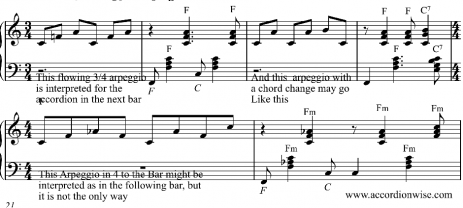
Plus a slow melody over the top of course. This is only the accompaniment!
The effect will vary depending on the relative octaves you are using (by and/or by octave selected) between left and right hands.
Your interpretation of the arpeggios may be just as valid and there are many more possibilities.
If you get mixed up just keep the movement of the notes going. It does not matter too much and I amy have not even given you the ideal interpretation.
![]()
Or here is a Simple version for a moving chord waltz
Three bars here are for this example, the others afterwards are different to illustrate the mantra of never using the same musical device more than three times.

The chords from the bass and the treble blend together one after the other for this waltz treatment
![]()
Listening with the brain. An even crazier and easier way to make bass arpeggios
This definitely should not work, and may or may not on your accordion. It underlines though that exactly the way you play anything on the accordion has an effect and is worth paying attention to.
One of the special modes available on the Roland FR-8x accordion is the ability to play different inversions of chords just by repeating the same chord. Each successive press rises higher and then either starts again at the bottom or returns down, depending on the mode sleected.
Of course it takes a lot more to create moving chords on an acoustic accordion, or does it?
I tried this with this and several others on my Voctoria accordion and heard something totally unexpected. It should sound much like the accompaniment pattern in Schubert's Ave Maria

IU believe this is a case of listening with the expectations of the brain rather than the ears. We do not see with our eyes litera,lly either, it is the brain that interprets.
Also if you feel that this is happening it will be comfortable for you.
Note that as well as increasing the volume level and then decreasing it in the first example it will emphasise the effect if you also paly the strongest note a little more legato than the others.
You could also substitute another bass note instead of the last chord of the series to make sure of the effect.
Then it may sound very much like this.

I will try to include a sound example for you to judge for yourself whether this is working, or whether I have been studying too hard.
It may work better on some accordions than others and prefer particular chords, but it certainly worked on several choices on my Victoria accordion.
It may be a hearing illusion, because if a note is played both louder and longer (ie more legato) it may be being dstinguished by the listeners brain as more important and therefore higher.
If you cannot make that work with all those notes try it as just a waltz with the third beat of the bar (the SECOND chord in the standard method) as louder and more legato (longer without disrupting the tempo). I am pretty sure you will hear the effect then on most chords.
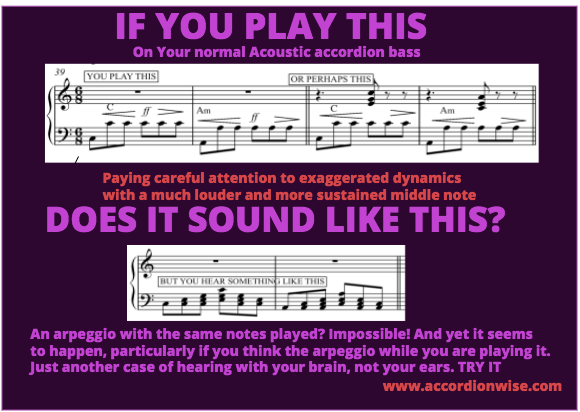
![]()
Effortlessly double a fast chromatic passage in the bass with Just Your three Most Used Bass Buttons!
A Great cheap trick!
You know this is what you all wanted!
So imagine that your right hand is playing a fast downward mainly chromatic run as a highlight in your Tango rendition, most likely at the end. I am talking up to eight notes played in maybe half a beat. But your listeners are astounded as they hear your left hand doubling up playing the same notes and keeps up effortlessly!
| BE SURE TO TRY THIS OUT YOURSELF |
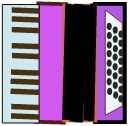 This is an illusion you can create in this example with sleight of hand and just your three most often used bass notes.
This is an illusion you can create in this example with sleight of hand and just your three most often used bass notes.
Right hand plays E D C# C B Bb A in a blur of notes. (OR just E D C B A very fast if not comfortable with the near chromatic run) In order to keep up with it the left hand plays just the first one of the run E the last A and one of the notes in between, B ibeing a really good choice as it is not just the easiest one but not in the middle of the run where it would stand out as a third.

You play just E B A at approximately the same time as they occur in the fast run, but join them up smoothly even overlap them, not staccato. The listener's imagination fills in the missing notes.
This idea can be used for other quick phrases, but the quicker the better or the illusion will be lost. Click the sound player below to play
|
KEEP READING THERE IS ANOTHER AMAZING ILLUSION NEXT |
![]()
Achieving the Impossible in Stradella Bass
Everyone knows that Free Bass was invented (deriving from the chromatic button systems) because there are a lot of things you cannot do on Stradella Bass. One of the advantages of Free bass is having more than one of each name note
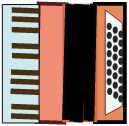
Your normal (stradella bass) accordion of course has only one example of each bass note and that means you cannot play the same note one octave apart therefore.
Why would you want to anyway? Well, extended arpeggios which have both a bottom note and a top note with the same note name sound rather nice and are very popular in music.
Think of tunes as diverse as Memory from Cats, What a Wonderful World and Schubert's Ave Maria and they all have a special beauty because of this style of arpeggio.
Here is a prime example, in gentle 12/8 style, notice that each arpeggio has a lower C then a higher C, or a lower A and a higher A, then a lower F and a higher F, and a lower G and a higher G. Clearly impossible to do on stradella bass, because it only has one of each.

Music shown is
C E G up to high C (down to) G E
A C E up to high A (down to) E C
F A C up to high F (down to) C A
G B D up to high G (down to) F D
You could play it on the treble (in fact to find out what it sounds like why not do so) but clearly not on the bass unless you had a free bass model.
OR IS IT IMPOSSIBLE ON STRADELLA BASS?
Well let us take this a step at a time. Here are the note shapes of the notes we have available on your stradella bass.
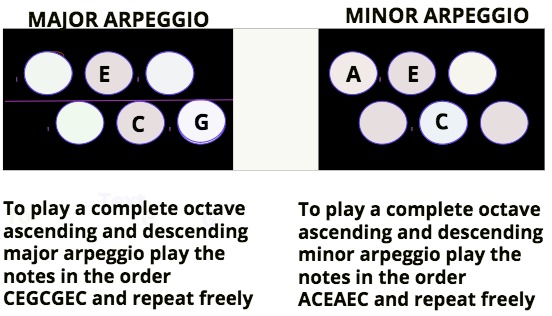
In fact all you have to do is play the notes through on your accordion in the correct order and you will hear it going up and down all the way. It is an illusion caused by the multiple octaves playing together in your bass sound. You should use one of your full multi octave sounds, though, not a very light sound.
Play CEGCGEG in that exact order from the left hand diagram, or just to make sure try GBDGBDG or FACFCAF or even ACEACEA
The ear picks out which octave it wants to hear. BUT play just C E G C and stop there and you will hear the same lower C each time!
When you play the G and E afterwards it decides it must have been wrong and hears the high C and then the low C after those notes have led you down to that expectation
I am not sure if it was my imagination hearing the higher octave more when it is played louder and that it drops down in apparent pitch when I drop the volume!
I think the key to this effect in as far as it works is that you do not hear with your ears or see with your eyes. In each case the deciding factor is your brain!
How to do This
Playing them in the right order is not easy. There are three different ways you can think about it to get it right
- Think carefully about each note's name as you play it
- Play the major chord first anti clockwise then back clockwise, and realise the minor works in the opposite way (and make sure the key note appears in the middle as well as the beginning and end)
- Remember when you are doing the fourth jump which will be on the same row (basic or counterbass) as the previous one,while the smaller the jump of a third will be moving between them.
- And another clue for you below with the counterbass notes marked in red.
C E G C G E C (C major arpeggio)
A C E A E C A (A minor arpeggio)
F A C F C A F (F major arpeggio)
G B D G D B G (G major arpeggio)
You will probably find the minor version more difficult to do because the root of the chord you are playing is in the counterbass row rather unusually.
The major chord arpeggios are mainly on the main bass row, while in the minor there are more notes from the counterbass.
There is of course another way of playing that minor arpeggio more closely related to the key note, but that one involves serious finger gymnastics and the choice of the easier one means it is handy to use as the relative minor of the major key you may be already using.
But if you would like to be close to the key chord related to the arpeggio here it is.
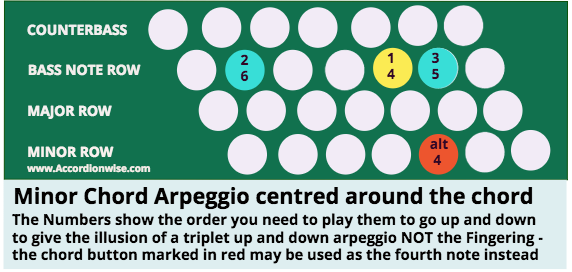
Also note the alternative possibility of replacing the fourth note of the series by the minor key chord (coloured red), giving a similar, but not identical result.
You can also do that with the major arpeggio version shown earlier.
THIS VIDEO WILL SHOW YOU HOW TO DO THE BASS ARPEGGIO EASILY
![]()
A Pseudo Boogie Bass
Oddly enough this uses the fake higher octave effect even though it is not the best way to represent that note pattern.
Here it is in a basic version with an example of each run used, though not all the repeats for a 12 bar boogie here at the moment.

In this exercise you will hear over an octave although it is not quite your normal "Guitar Boogie" style pattern
Adding extra notes to liven this pattern can work wonders,
eg C C ECE G G AGA C C A A G G EGE to take an extreme example treatment from just the first two bars of the example
PLAYING TIP ALSO TRY THIS
Though not the exact boogie bass this one has the advantage that you can easily add a major chord between all the bass notes on it as another way to liven it up.
Let us stay with this for a moment to use it as the basis for a jogalong cowboy style, (which can of course be played faster for other uses too).
This pattern having for example the extra A which is the 6th in C6 (but in this case, ignoring the major third E, which is taken for granted). It will feel extrremely famiiar, just think Wandering Star.
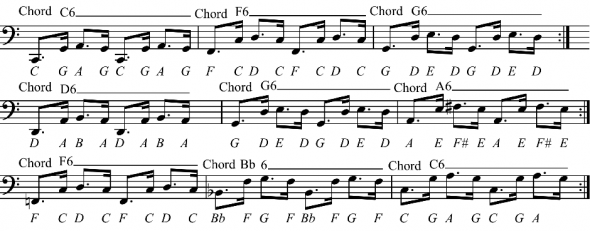
Note that the sixth part of the chord (eg the note A in C6 chord, E in G, G in Bb etc) could be played on the flat side below the key note on the counterbass or above on the sharp side as the next but one button up on the basic chord row.
If feeling extra pernickety, try the alternative fingering depending on where the next chord is. Just so as to be ready for a change of hand position if there is one. It is a good habit to be able to do but not essential, though it will make the transition to the next position smoother.
This maintains a basic principle of bass note playing, which is to keep your phrase so you can play it without moving your hand position. It makes life easier and that is good. Save the complicated moves for where they are necessary. Life is difficult enough!
Try also livelier variations such as C G A G C G AGA (That is just one bar) which will lead you to the next chord nicely
![]()
Alberti Bass
This is an ancient way of Chord outlining with bass notes onlysuch as below.

Alberti Bass was used with harpsichords and early pianos to play chords and rhythm simultaneously because they did not sustain the notes very well for you to appreciate the chord's sound.
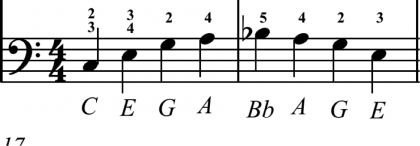
Alternative fingerings given on the first two notes, but your fifth finger takes a bow on the Bb supported well by the 4th finger it is propped against. If you cannot bring yourself to trust the little finger here just squeeze together the left side of your left hand and it will bring the fifth finger down!
Useful Tip
Just two bars based on one chord in the boogie bass motif makes a useful lead in to the next section. The real one just above leads to the subdominant in the next bar (in this case of course to F). The pseudo easy version just marks time so could stay on the same chord after.
![]()
Other uses for Casual Mini Arpeggios
You can also use two or three notes from the arpeggio C E G, F A C, Bb D F, A C# E or whatever in any order in your bass pattern without the expectation of hearing the extra note.
If you use it four times as in C E G C and follow it with D it will stay in the lower octave by the way.
As long as you keep inside the beat you can add fast bits or hang on to a note for two or maybe three beats in your mini arpeggio and will find nice effects for either staying on the chord shape or moving to the next one.
This is less likely to be useful with the minor mini arpeggio given as you would not be over the right chord to decorate casually with it.
Note that you do not have to complete the full range to get the higher octave effect, just C E G C G or D F# A D A will do it. It depends how much room you have to put it in. You may think this is not usable, but you may be starting the arpeggio after the beginning of a beat for example.
EXTRA TIP
Dont limit yourself to root position arpeggios, try E G C E C G etc first inversion, or G C E G E C etc and listen to see if it still works.
![]()
Chords which appear to move between inversions
Everyone knows that one of the unfortunate limitations of the easy chord system which is known as your stradella bass on accordion is that only one inversion of each chord is available. So you play the chord twice and you get exactly the same note, which can sound rather static.
However first play C C chord C Chord as in the most basic waltz pattern. Then try C C7 C7, that too stays static as you would expect.
Now play C C7 G dim. Just a little awkward involving a diagonal movement up to the G dim. And disregarding what your fingers tell you, you should hear C C7 C7 but that the second C7 (actually G diminished) moved up to a different inversion. (There is a reason explained on another page)
Then use it in a chord progression back to the chord it wants to go to. The G dim version wants to go to the F chord even more than the original version C7
There was a discussion about using the thumb on the bass buttons on a forum the other day and I dismissed it out of hand when someone said they used thumb on their diminished chords.
I too can be closed minded at times!
However for that chord sequence it seems to work on the second pseudo C7 (played as G dim) without playing two chords at once or mangling the hand too horribly. It does allow you to get back over to the F without stretching too much, whcih is not as easy as usual when using this substitution
This works with most makes of accordion, but do check yours to make sure the notes in your chords were not selected differently by your accordion maker.
This will not work in all keys the same way however because of the ways the accordion reeds are selected.
![]()
What do your chords actually consist of? Your chords are not playing exactly what you think!
This is because (for each bass voice) they are derived from just 12 reeds normally C up to B natural. This means that the actual inversion used has to fit inside a space of one note less than a complete octave of notes.
Also because in the case of sevenths chords, both standard 7ths and diminished 7ths, they play an acceptable version of the chord but not the complete one.
The normal bass seventh chord does not include the fifth. Hence think G7 is G B F The diminished seventh chord does not include the fifth either so D diminished plays D F B. The full version of G7 is of course D F G B
To use this odd fact read on.
![]()
Extra uses of the seventh chords. Alert: You do not have any diminished chords!
People with five bass row accordions (60 or 80 bass) can still play with diminished chords and are not as disadvantaged as they think
Indeed in one sense even a 120 bass accordion has NO DIMINISHED CHORDS, only ones which are disguised as diminished chords by the way they are used and the extra notes being filled in by the right hand.
The diminished chord is just COMPATIBLE with the key name you are working with. You can actually play a similar diminished chord by using the button directly below in the normal sevenths row. So for C dim you can play F7. Something all five row bass owners should know.
Whether you hear a normal seventh chord or a diminished chord really depends on musical context and what notes are being played with it in theright hand.
|
Just Remember This |
To get Bb diminished play Eb7 instead For F diminished play Bb For C diminished you can also use F7 For G diminished use C7 For D diminished use G7 To get A diminished you can also use D7 and so on and so on... |
You do not need to remember this list to use it. Just reach down in the 7th row instead of across to the diminished row to find the diminished equivalent.
An advantage of this system is that with a seventh chord you can do a kind of augmented version by sharpening the fifth. OK I will put that into English for you,
C7 chord play or include a G# (Ab)
with G7 chord play D#
with D7 chord play A# (Bb)
with F7 chord play C# (Db)
etc.
Do not try this with the major or minor chords however which already have the major fifth in them.
![]()
Melodic Snippets in the chords in the Accompaniment
You do not have to conifne your bass note or your bass chord playing to using one of each alternately of course. Let us look at Chord Changes as an extra melodic part Here we are talking mainly about chord moves with no bass note between them.
If you get these right it is very subtle and impressive.
You can of course do a quick shuffle there and back to the next door up or down chord and that works when you come straight back to the normal. But you can also create a pseudo trill to and fro with the button one note apart below or above.
Just a quick illustration of what I mean but you can probably do better than this just trying similar stuff out on your accordion. These are momentary chord changes that do not affect the overall harmony.

If your first chord is a minor chord you can go either down to the major chord a tone below or up to the minor chord below without affecting the apparent key you are working in. So, slightly easier than the diagram shows, that is down one jump to major or up to minor
With major chords you can only jump up to a minor chord to avoid accidentals (and therefore an accidental key change!) in the chord.
If the next chord after that is a different one playing triplets inside the beat should work well.
You might like to try and listen to a few chord only changes. G to F (alternate same row) is not difficult. Also Gm to Dm same row next door. OR G to Dm next door next row. Or even the useful but mpore intimidating C to Am chords, done with either a rather big stretch or the 5th finger on the C.
I should not tell you this but almost any quick access to another chord with a quick return to the original chord in triplets will not sound too bad!
![]()
It is very easy to remember just to stay in the same row and miss one button to get to the next whole tone distance, either up or down as required.
But in the diagram an orange note to a pink note is one full tone apart, an A to a B or a Bb to a C for instance.
The move crossing into the counterbass is slightly less obvious. As in basic row D to counterbass E belonging to C chord. Again missing a note but crossing over as well. From orange button to purple button in the diagram.
It is easy to forget that you can use the alternate buttons in the counterbass row for the next note a tone apart also!

![]()
Bass Buttons One Semitone Apart and the Chromatic Scale
Why learn to move chromatically
A chromatic movement down (for instance C to counterbass B) makes a nice strong way of going to the dominant chord (m in this case G.
Likewise the wider spaced cross row chromatic movement from C up to C# leads you subtly to the chord of D with very strong harmony.
If you can play it fast a section of the chromatic scale makes a very nice embellishment.
Here is how to make a section of a chromatic scale.
Quite similar spacing! This also misses two buttons out between. However the long diagonal movement does feel rather large!

To do a full chromatic scale continue the system. As long as you keep going with the diagonal and miss two buttons system you can end up on notes you did not have time to identify, e.g. C in the counterbass which is really a B#.
Just learn and utilise the movements involved then try this!

Yes it starts on the G button next upwards to the marked C button and keeps on going up but it finishes further very near the top of a 98 or 120 bass accordion on C. On 72 bass or smaller you will not get that far.
To help a little I have indicated the jumps and marked the counterbass notes in red on this version below
G F#G G# A Bb B natural C
or for another example of this note pattern
F E F F# G G# A Bb
(which seems even crazier)
and lots more like it in other keys once you have learned the movements to make.
By following the learned sequence of buttons for the chromatic scale you just found a note you did not even know was there!
We all know there are no more natural keys or flats up there of course so where did that come from and have you confidence to keep going up until you get to it? Well, of course it was really a B#, but that will stand in nicely for C.
To do this you need a lot of confidence to sound convincing, but just recall those movements for getting between the notes of the chromatic scale which you have programmed into your fingers and it is fine.
Of course it would have been nice to have had a chord to go with the final note but since it finishes in the counterbass row it does not match. To do it with that pattern you would have to start in the counterbass row after working how far you had to go down.
Here is another diagram for you. The second one may lead you into strange enharmonic lands where you play what is the right note at the end but cannot understand why! It is the land where double sharps may lurk in dark corners!
![]()
A chromatic scale and a modified almost chromatic scale
The lower example is mainly chromatic but incorporates one full tone move at the beginning. This, as well as sounding slightly different, helps you stay inside a smaller area of the bass keyboard.
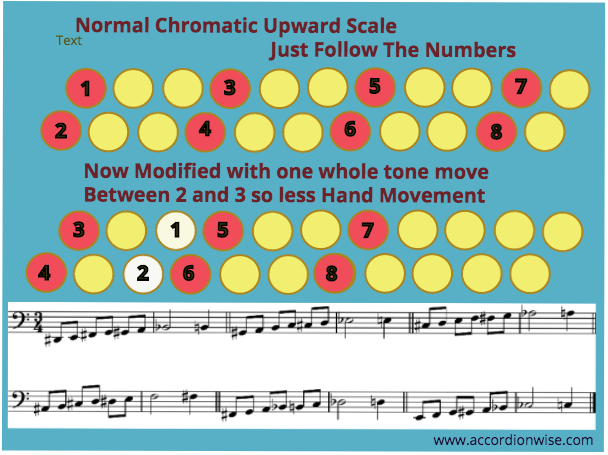
Notice that it is the note order that is represented by the numbers NOT THE FINGERING!
However the use of the fifth finger if you can manage it on note 2 of the normal chromatic scale may be helpful instead of using just 2 or 3 fingers, while the fifth finger on note 4 of the modified version is probably essential.
![]()
How you can use Chromatic Moves to make better harmony
Moving one semitone at a time is very good for creating a strong pull towards the next note. Either upwards or downwards, simply because the notes are so close together in pitch that it seems a shamer not to carry on doing it!
The descending bass line createds a very interesting chordal pattern and very intense harmony. It is no accident that the easy movement of C to B natural on the accordion leads you to harmonise it with the chord of C and the chord of G for which the B natural is alongside in the counterbass.
Continue to Bb in the chromatic downward run and you could have a chord of Bb or more likely the less handy G minor.
Down to A and you would use chord F (more difficult to swop up to the sharp buttons and use the chord of A)
Down Ab for Ab or F minor.
Even this can get a bit crazy, but if this has started you thinking chromatically that is a big step forward.
![]()
A chromatic run with right hand chords in contrary motion
Using contrary motion (the opposite way up or down that the treble part is moving) is very effective

Notice that the chords in the right hand are going up, whereas the bass line is going down chromatically.
This would also work with these chords in different inversions where the top notes of the melody went up.
The right hand chords are named ccorrectly, although the D9 takes into account the existence of the D in the bass
If I had used the same system, taking all notes into accounr with the G chord and E bass, I should have named it E minor 7.
In a nice rich jazzy harmony only the first and last notes might have fitted in with the chords, the effect being justified by it resolving nicely at the end. This would be delayed gratification!
![]()
Three Chromatic notes linking a very common chord sequence
Here is an interesting riff I found while trying out a way to play All of Me. I will leave it to you to work out where it should be. I imagine you will use the second version shown in C.
Hint strong riffs like this are most often found at between important phrases of a tune rather than in the middle of them. At least until you get into more advanced musical arrangements.

Bars i and 2 show an example in E,bars 3 and 4 in E
The last notes shown could also be E and A (in E) pr C and F (in C)
Or the second bar could vary according to the chord sequence, for example C# minor with the E version or teh matching A with the C. In each case this would modulating to that new key.
But there are lots of other possibilities.
Interestingly, the two examples are not the same on the final note if you examine them closely or play both. They would have been if I had given each one separate key signatures!
This is an example of varying the bass in an interesting way by changing the notes used to quavers (eighth notes) for a while.
An escape from the boring repetitive bass. An escape can also be made by using longer bass values such as minims (half notes)
![]()
A Fast Chromatic run to try
These are six examples of the same run, which should be played pretty fast as soon learned.
Notice that the chromatic part of this run starts on the second note of the run and that the ssecond note is on the counterbass row.
Having Difficulty using your 5th finger?
At the beginning of each you have a choice of fingering whether or not to use the fifth finger.
It is is one of the easier ways to use the fifth finger, it being supported by the fourth finger right beside it playing first but you do have to make sure the little finger stays in the right row.
Being shorter it may want to wander back into the chord rows! It will be easier to use in the sharp key buttons above C and tend to be pulled the wrong way in the flat keys when the wrist is pointing upwards or downwards towards one or the other.
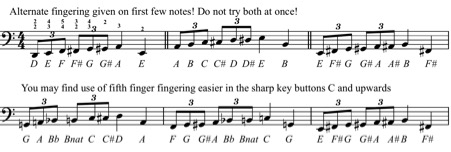
This will sound quite impressive played in strict time, fast and with accents on the main four beats of the bar.
![]()
Combined chromatic Run with chords
This is a very short chromatic run with a chord in between some of the notes. I decided not to do the chords where the fingers would twist off the hand, but suggest the other part be played legato, joining up the notes and chords fully.
Possibly I could have put a quick chord with the E also. This would have made the last four notes all quavers (eighth notes).

I feel that playing that playing the bass NOTES legato emphasises the harmony and ensures you get the feel of where the button relative positions are.
It is certainly a useful exercise to add facililty to your left hand.
![]()
Use the Chromatic move for bass emphasis
You can further emphasise a main chord note by adding a clipped note a chromatic note under it. For instance Inside the beat for E in the bass you can first clip in a strong D#.
That was easy, so let us try extending it with the chromatic note below that and play D D# E again without taking an apopreciable time, or you could add D D# as a very brief run to embellish it before E on the beat.
To occupy one whole beat leading up to a main beat (in semiquavers or 16th notes) you can extend this with two extra notes. Simply start with the note you are going towards which is E in this example, go down to the D# and D and do what you learned before. E D# D D# E
![]()
Minor 3rd and Major 3rd in bass
The major third upwards is so easy to play of course whereas the minor 3rd to go with the minor chords is a long way away, with two buttons to "jump over between" and may even require the little finger to accomplish.
This can be a bit dodgy and requires a fair stretch between the fingers to get down there if you are not using your little finger.
Fifth finger use can be dodgy, not just because of relative weakness, but because the little finger (being shorter) will want to reach a chord row instead. This is less likely at the top end of thebutton keyboard when the line will be altered by the hand pointing upwards.

This diagram works to give you several different bass run variants. Four or five note and even chromatic (though that is covered in the earlier diagram further up this page)
You could also work this out note by note with the earlier reminders of how small and larger next door note distances work.
